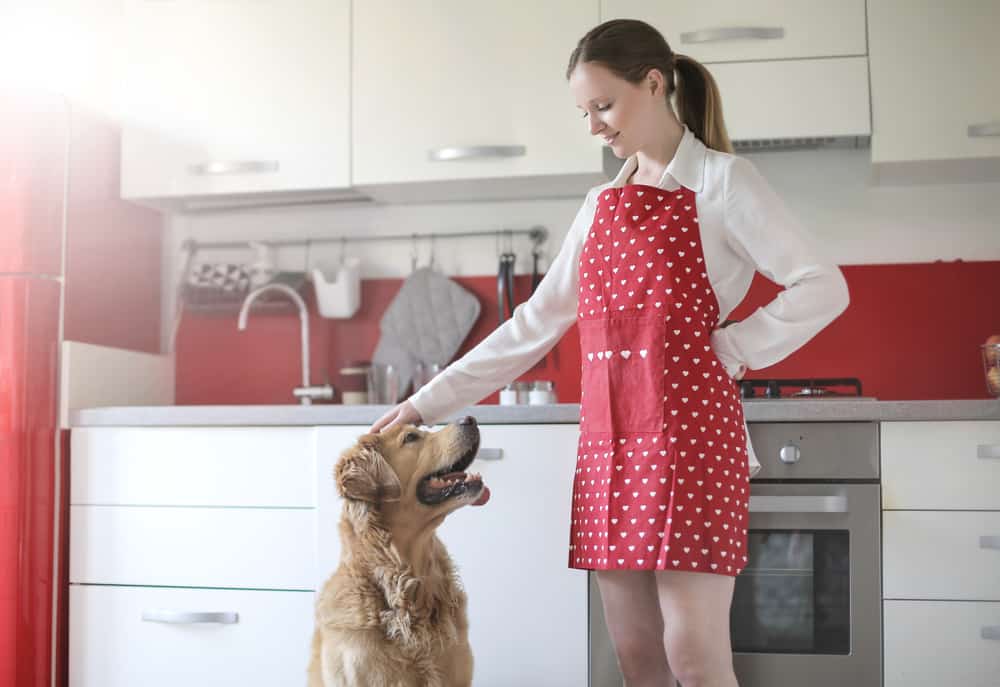How to Stop a Dog from Counter Surfing

You’ve just baked a delicious batch of cookies, and you leave them to cool on the counter while you get changed. The mouth-watering aroma wafts throughout the house and it’s irresistible – for you and your dog.
When you finally return to the kitchen, you’re not greeted by the sight of freshly baked cookies. Instead, you’re greeted by an empty plate and your four-legged friend sitting beside the counter, licking their lips.
The crime scene is clear: your hard work is now in your dog’s stomach and all you have to show for it is a few measly crumbs.
Counter surfing can turn your best friend into the most annoying housemate – you’ll find yourself hiding food in strange places and watching them like a hawk whenever there’s food nearby. Yet counter surfing is not just frustrating; it can also be incredibly harmful for your dog.
Why Is It Bad for a Dog Counter Surf?
Avocados, grapes, raisins, chocolate – many foods we consume regularly are actually poisonous for canines. A dog’s digestive system can’t process food in the same way we do.
Even if a dog doesn’t eat anything poisonous, counter surfing will inevitably lead to disaster. Countertops are littered with sharp objects and breakable kitchenware, and a dog’s haste to scoff down food could result in them choking, eating plastic wrapping or burning their mouth if the food is piping hot.
If your dog is a counter surfing addict, their behavior may seem impossible to rectify. But don’t worry, you can protect your dog (and that batch of cookies!) if you take proactive steps. But before I explain what these steps are, it’s important you understand why your beloved companion has an overwhelming urge to steal.
Why Does a Dog Counter Surf?
Dogs are scavengers and opportunists by nature. It is in their instincts to consume any food in sight. In the past, they needed this drive to survive. They weren’t given nice bowls of food routinely every day. Instead, they had to traverse many miles in the wilderness, never knowing when their next meal would be.
Put simply, dogs find food irresistible, and they’ll take any opportunity to get their paws on more food. Counters are pretty much a tempting banquet – food, crumbs, leftover dishes, uncleaned spills and even used napkins all make for a delicious treat.
If your dog counter surfs and finds something tasty, they’ll keep counter surfing in the hope of finding more scrumptious treats (their behavior becomes reinforced).
Effective Ways to Stop a Dog From Counter Surfing

Sometimes, the best way to stop a dog from counter surfing is to prevent it in the first place. Luckily, these methods can help you to do just that!
Preventative Measures
If you want your dog to unlearn their pesky counter surfing habit, you need to take preventative measures. These measures prevent your dog’s counter surfing behavior from being rewarded or encouraged.
Do Not Feed Your Dog Table Scraps
We’ve all been there: your dog looks up at you with that adorable puppy eye stare. You think to yourself one bite couldn’t hurt. But despite how endearing your beloved companion may look you should never feed your dog table scraps.
Feeding your dog table scraps reinforces their counter surfing behavior. You’re telling them it’s okay to eat food off the table and any leftover food is theirs for the taking.
Giving your dog table scraps also puts them at greater risk of developing health issues such as obesity and digestive problems. And as mentioned earlier, many foods we eat are dangerous for dogs.
Keep Counters Food Free and Completely Clean
When your dog jumps up and finds something delicious on the counter, their behavior is being rewarded so they’re going to repeat this behavior. However, if your counters are food free and completely clean (no leftover crumbs, spills or lingering scents), when your dog does counter surf, they won’t be getting rewarded.
Removing any chance of reward tells your dog that counter surfing isn’t worth their time and they’ll eventually stop.
Of course, there will be occasions where you won’t be able to keep your counters clean and food free. Perhaps you’re cooking a meal, or perhaps you’re hosting a dinner party and need to leave nibbles out for guests. If this is the case, you should try the next preventative measure:
Blocking Access to the Food
If your dog has access to the kitchen while you’re cooking, they’ll always be tempted to counter surf – there’s just too many irresistible smells and enticing sights!
By blocking their access to the kitchen they’re not going to have the opportunity to counter surf and then be rewarded for it.
You can use a doorway gate to prevent your dog from entering the kitchen, you can shut them in a different room, or you crate them (only crate your dog if it’s for a short period of time).
Reward-Based Training Measures
Reward-based training (positive reinforcement) involves encouraging your dog to behave the way you want by rewarding the behaviors you like. With the right reward-based training measures, you’ll soon be able to have your dog’s favorite food on the counter without their muzzle continuously nudging you!
Teach Your Dog “Leave It”
If your dog doesn’t know the “leave it” command now is a good time for them to learn. Not only can “leave it” be used to tackle counter surfing, it can also be used in various other situations. For example, when you want your dog to back off from another dog or want them to drop something they’ve snatched.
To teach your dog the “leave it” command follow the training steps in this video.
After your dog has learned “leave it” you can use the command to stop them from counter surfing.
If you see your dog eyeing up that pie on the counter, air scenting and getting ready to pounce, interrupt your dog by telling them your “leave it” cue. When your dog directs their attention back at you, praise them and give them a treat.
Mat Training
Sometimes you may be too busy to keep a close eye on your dog while preparing a meal. “Leave it” isn’t going to work if you can’t monitor their behavior and spot when they’re about to pounce. This is where mat training comes in handy. Mat training involves teaching your dog to stay on a mat until you permit them to leave.
To mat train your dog, follow the training steps in this video.
Make sure you train your dog to stay on the mat for a long duration – enough time for you to prepare a meal and then wipe down surfaces. To accomplish this, during training you’ll need to gradually increase the amount of time until you give your dog the release cue.
Reward Your Dog for Keeping All Four Paws on the Floor
Another training technique you can try is rewarding your dog for keeping all four paws on the floor. This will encourage your dog to recognize for themselves that staying on the floor is a much more rewarding experience than jumping up on the counter.
This training technique is fairly straightforward – all it requires is patience and good timing. If there’s food on the counter but your dog isn’t jumping up, reward them with treats and praise. If your dog is practicing a good behavior like sitting or lying down, reward them with a treat of higher-value (food they like more).
Eventually, your dog will perceive the floor as a great place to be (highly rewarding), and they’ll no longer care about what’s on offer on top of the counter.
During Training, Proof Your Dog’s Behavior
For training to be effective you need to slowly build up the difficulty by proofing. For example, if you start trying to teach your dog to keep all four paws on the floor when their all-time favorite food is on the counter, chances are, they aren’t going to stay sitting on the floor whatsoever.
In the above scenario, you would need to initially start training your dog when there’s a low-value food (food they aren’t fond of) on the counter. After they successfully keep all four paws on the floor around this food, only then would you train them around a higher-value food.
For more information about proofing read this in-depth guide.
Make Sure Your Dog Never Gets the Food on the Counter
If your dog is able to snatch food off the counter, it will simply reinforce their counter surfing behavior and your training will go to waste. If your dog jumps up and tries to steal the food, cover the food with your hand to prevent them from taking it. When they give up and return to the floor, give them a treat as a reward.
You can also leash your dog during training. This will allow you to maintain control and pull them back if you see them about to lunge for the food.
How NOT to Stop a Dog from Counter Surfing

If you catch your four-legged friend in the act, your initial impulse might be to shout at them. However, shouting at your dog is not an effective way to change their behavior. In most cases they won’t understand why you’re scolding them; are you mad at them because they’re not looking at you? Jumping up? In the kitchen? Not sitting?
Even if your dog does recognize you’re chastising them for counter surfing, they probably won’t stop. After all, their counter surfing has still been rewarded with a tasty treat. Punishing your dog will just teach them that you don’t like what they’re doing, and they need to counter surf when you’re not nearby.
Shouting at your dog can also startle them and cause them to become anxious and fearful of their surroundings.
Some recommend using a shock collar, scat mat or noise alarm to stop your dog from counter surfing. These are all forms of aversive training – they cause your dog to associate jumping up on the counter with an unpleasant experience, deterring them from repeating this behavior in the future.
I advise against using aversive training measures. While they may stop your dog from counter surfing, the side-effects can be great. Your dog may develop anxiety, refuse to enter the kitchen, avoid interacting with people or even become aggressive.
In fact, a 2017 study on the effects of using aversive training measures found that dogs trained with these methods were more likely to display aggression and develop destructive behaviors.
The kindest and most effective way to stop your dog from counter surfing is using a mixture of reward-based training measures and preventative measures.
Other Things Counter Surfing May Be a Sign Of
Counter surfing may not just be due to your dog wanting a tasty treat. These other reasons may be behind your dog’s behavior.
Boredom
A lack of exercise, not enough mental stimulation or being left alone for long periods of time are all factors which can lead to boredom. A bored dog is an unhappy dog and they’ll probably engage in various destructive behaviors (including counter surfing) in an attempt to overcome their boredom.
A bored dog is particularly likely to partake in counter surfing because working for their food, rather than taking the easy option of eating the food provided in their bowl, can actually relieve their boredom.
Exercise and mental stimulation are vital for a dog’s well-being and happiness. It is your responsibility to ensure your dog is getting enough exercise and mental stimulation throughout the day. You should also ensure your dog is not left alone for too long.
Wanting Your Attention
This typically occurs when a dog has previously counter surfed and gained a reaction from their owner.
If your dog is counter surfing with the sole purpose of gaining your attention, you need to take a slightly different reward-based training approach. Assuming your counters are clear (preventative measure one!), do not interact with your dog when they’re counter surfing.
After they give up and walk away, reward them by playing with them, taking them on a walk or another activity they enjoy. This will teach them they won’t gain your attention through counter surfing.
Separation Anxiety
If your dog suffers from separation anxiety, they might engage in destructive behavior when you’re not around, like counter surfing, chewing furniture, pacing and continuous barking.
A dog may suffer from separation anxiety if they have been neglected in the past or experienced drastic lifestyle changes.
Some breeds are also more prone to separation anxiety (particularly companion dogs). If you think your dog is suffering from separation anxiety, it’s important you take the necessary steps to help them.
Hunger
You might not be feeding your dog an appropriate amount. Keep in mind every dog has different needs, and what they should be eating is based on many factors like their breed, size, age and energy level. Hunger is certainly going to make your dog desperate for any food they come across!
However, if your dog is well-fed and they’re still exhibiting signs of hunger, or you notice they have an increased appetite, an underlying medical problem could be the cause.
Diabetes, parasitism and Cushing’s disease can all cause an insatiable appetite (polyphagia). Make sure to get your dog checked if you have reason to believe they have an underlying health problem.
Final Words
Using reward-based training and removing any temptation will ensure your dog truly overcomes their pesky habit. Soon you’ll be able to bake cookies without fearing thieving paws, have stress-free dinner parties and feel proud as relatives comment on how well-behaved your beloved companion is!




